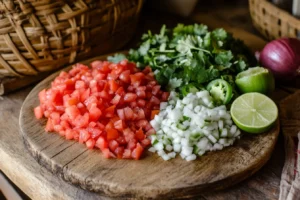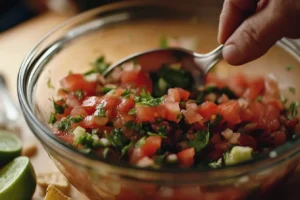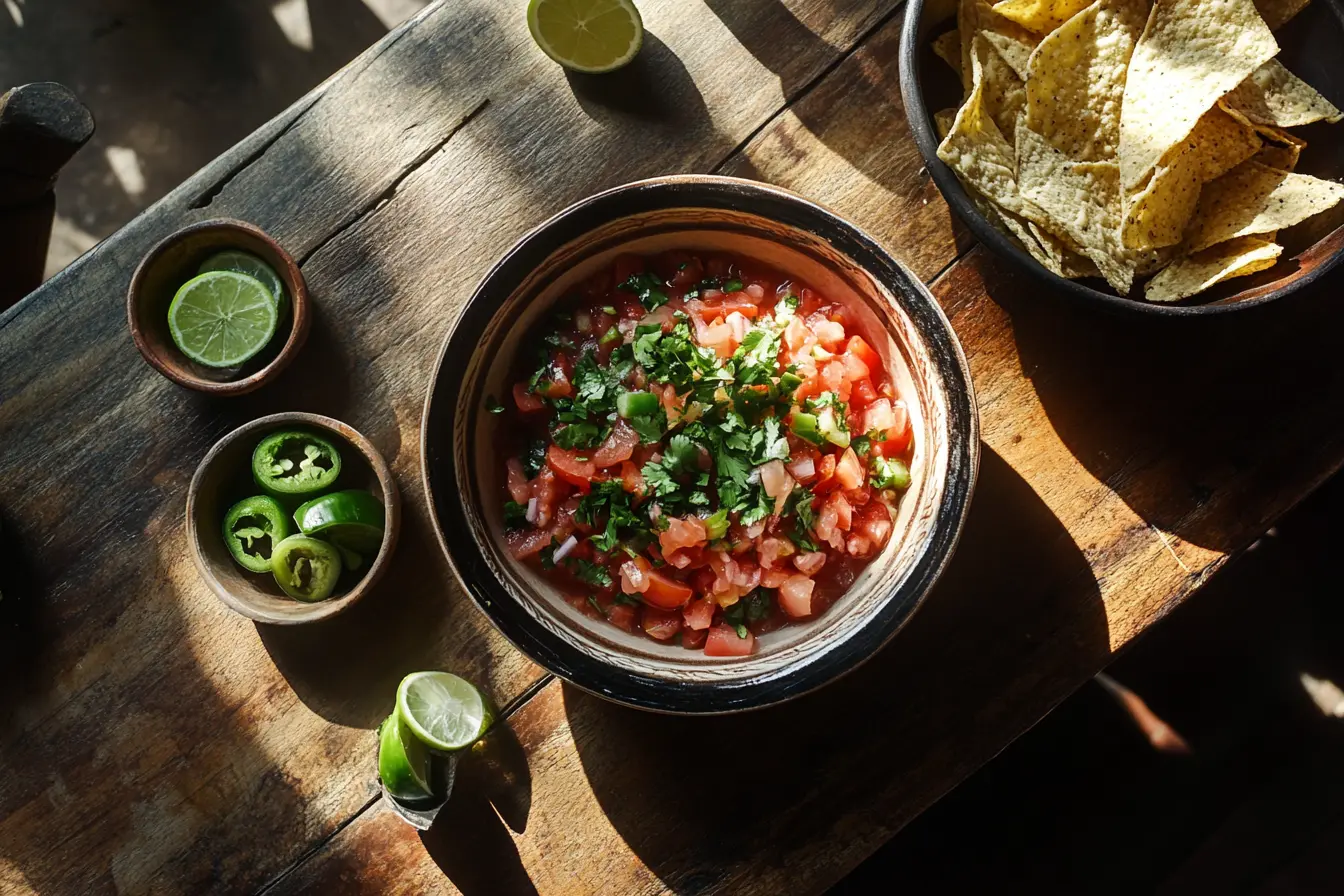Fresh tomato salsa is more than just a dip—it’s a symphony of bold, tangy, and refreshing flavors that can transform your meals. Whether you’re hosting a party, meal-prepping, or simply craving a quick and healthy snack, this salsa recipe with fresh tomatoes is your go-to guide. From choosing the freshest ingredients to tips for achieving the perfect texture, you’ll learn everything there is to know about crafting this versatile dish. Let’s dive right in and uncover why fresh tomato salsa should always be in your recipe arsenal.
Why Fresh Tomato Salsa Is a Must-Try Recipe
The Unique Appeal of Fresh Tomato Salsa
There’s something magical about the flavor of fresh tomatoes when paired with crisp onions, zesty lime juice, and fragrant cilantro. Unlike its store-bought counterparts, homemade salsa packs a punch of natural sweetness, vibrant colors, and a texture that simply can’t be replicated. But it’s not just about taste—it’s also healthier, offering a low-calorie and nutrient-rich alternative to many processed dips.
Homemade vs. Store-Bought Salsa
Why settle for store-bought salsa when you can whip up a batch that’s fresher, tastier, and free of unnecessary additives? Commercial salsas are often laden with preservatives and artificial flavorings, dulling the vibrancy of real ingredients. With a homemade salsa recipe with fresh tomatoes, every bite bursts with garden-fresh goodness, giving you a flavor profile tailored to your exact preferences.
What Makes Fresh Tomatoes the Best Choice?
Fresh tomatoes are undeniably the heart and soul of this recipe. The juiciness of ripe, garden-picked tomatoes elevates the salsa’s texture, creating a balance between chunky and smooth. Roma tomatoes are an excellent choice due to their firm flesh and low water content, but heirloom or vine-ripened tomatoes can also work wonders for a more robust flavor. Whatever type you choose, the freshness of the tomatoes will make or break your salsa.
Salsa in Global Cuisine
Origin and Popularity of Salsa
Salsa’s roots can be traced back to the Aztecs, Mayans, and Incas, who created variations of this beloved condiment using native ingredients like tomatoes, chili peppers, and salt. Over time, salsa evolved into a global staple, becoming synonymous with Mexican cuisine and beyond. Today, fresh tomato salsa is cherished in kitchens worldwide for its versatility and bold taste.
Different Types of Salsa and Their Uses
While fresh tomato salsa is a classic, there are many other variations to explore—like roasted tomato salsa, salsa verde, and mango salsa. Each has its unique flavor profile, with fresh tomato salsa reigning supreme as the most versatile. Use it as a dip, a topping for tacos, or even as a base for your favorite Mexican-inspired dishes.
How Fresh Tomato Salsa Stands Out
What makes fresh tomato salsa so special? It’s the simplicity of its ingredients combined with the flexibility to tweak it to your liking. Whether you want a chunky salsa loaded with vibrant textures or a smoother consistency that clings perfectly to chips, this recipe allows you to customize it with ease.
Ingredients for Fresh Tomato Salsa
Essential Ingredients for a Flavorful Salsa Recipe with Fresh Tomatoes
To make the best salsa recipe with fresh tomatoes, selecting the right ingredients is key. Not only do the individual components bring unique flavors to the dish, but their combination creates that irresistible burst of freshness. So, let’s break down what you’ll need to get started.
 Fresh Tomatoes: The Star of the Recipe
Fresh Tomatoes: The Star of the Recipe
It all begins with fresh, juicy tomatoes—after all, they are the foundation of this recipe. While Roma tomatoes are a classic choice due to their dense texture, vine-ripened or heirloom tomatoes can also add a deeper, more nuanced flavor. Whichever variety you choose, make sure your tomatoes are ripe but firm, with a deep red color and no soft spots. If you’re lucky enough to have garden tomatoes, their natural sweetness will take your salsa to the next level.
Supporting Ingredients for Balance and Flavor
While tomatoes steal the show, it’s the supporting cast of ingredients that truly brings your salsa to life. Here’s what you’ll need:
- Onions: Choose either white or red onions for a sharp, crisp bite.
- Garlic: A small clove of garlic adds depth without overpowering the fresh flavors.
- Jalapeño or Serrano Peppers: For a kick of heat, these peppers are essential. Adjust the quantity based on your spice tolerance.
- Lime Juice: The acidity of lime juice brightens the salsa and balances the sweetness of the tomatoes.
- Cilantro: Fresh cilantro leaves add a signature herbaceous note, tying the flavors together beautifully.
- Salt and Pepper: Season to taste. A pinch of salt amplifies all the other ingredients, while freshly ground black pepper provides subtle warmth.
Ingredient Substitutions and Additions
Creative Substitutions for a Twist
Can’t find certain ingredients or want to try something new? No problem! Salsa is incredibly adaptable. For example, if you don’t have Roma tomatoes, you can substitute cherry tomatoes for a sweeter taste or plum tomatoes for a softer texture. Similarly, lemon juice works well in place of lime, especially if you want a slightly different tang.
Optional Additions for Extra Flavor
If you’re feeling adventurous, you can customize your salsa with additional ingredients. A handful of diced avocado adds creaminess, while a sprinkling of corn kernels brings a touch of sweetness. For something heartier, black beans can provide a protein-packed twist. The beauty of homemade fresh tomato salsa is that you can make it uniquely yours.
Step-by-Step Instructions to Make Fresh Tomato Salsa
How to Make the Perfect Fresh Tomato Salsa
Crafting the perfect salsa recipe with fresh tomatoes doesn’t require fancy equipment or complicated techniques, but it does require attention to detail. By following these step-by-step instructions, you’ll end up with a bowl of salsa that’s bursting with flavor and freshness.
Preparing the Ingredients
Before you start mixing everything together, it’s essential to prep your ingredients properly. Here’s how to do it:
- Wash and Chop the Tomatoes: Rinse your fresh tomatoes thoroughly under running water. Once clean, remove the stems and dice the tomatoes into small, uniform pieces. This ensures a consistent texture in your salsa.
- Dice the Onions and Peppers: Finely chop the onions and dice the jalapeño or serrano peppers. If you prefer a milder salsa, make sure to remove the seeds and membranes from the peppers.
- Mince the Garlic and Chop the Cilantro: Use a knife to mince the garlic finely. Then, roughly chop the cilantro leaves, leaving out the stems if you prefer a lighter, cleaner flavor.
Mixing and Combining the Ingredients
Now that your ingredients are ready, it’s time to bring everything together:
- Combine in a Bowl: In a large mixing bowl, add the diced tomatoes, onions, peppers, minced garlic, and cilantro.
- Add Lime Juice: Squeeze fresh lime juice over the mixture. The lime’s acidity not only enhances the flavor but also keeps the colors vibrant.
- Season to Taste: Add a pinch of salt and a dash of freshly ground black pepper. Mix everything gently with a spoon to combine the flavors evenly.
Pro Tip: Taste your salsa as you mix. If it feels like something is missing, it probably is! A little more lime juice or an extra pinch of salt can make all the difference.
Adjusting the Spice Level
How to Make a Mild, Medium, or Spicy Salsa
Adjusting the spice level of your fresh tomato salsa is easier than you think. If you prefer a mild salsa, stick to one pepper and remove its seeds. For medium heat, add two peppers with the seeds removed. On the other hand, if you love a spicy kick, include an additional pepper or keep some of the seeds intact. Remember, the spice level often intensifies after the salsa sits for a while.
Perfecting the Texture: Chunky vs. Smooth Salsa
The texture of salsa is a matter of personal preference. If you like your salsa chunky, dice the ingredients coarsely and mix them gently to maintain their shape. However, if you prefer a smoother salsa, pulse the mixture a few times in a food processor—but be careful not to overdo it! Over-processing can turn your salsa into a sauce rather than a dip.
Storing Your Fresh Tomato Salsa
Best Practices for Refrigeration
Once your salsa is mixed and seasoned, transfer it to an airtight container for storage. Refrigerate for at least 30 minutes before serving to allow the flavors to meld. This resting period is crucial—it takes your salsa from good to great. Fresh salsa will stay good in the refrigerator for about 4-5 days, so you can enjoy it all week long.
How Long Does Fresh Tomato Salsa Last?
While homemade salsa doesn’t last as long as store-bought options due to the lack of preservatives, it’s worth the trade-off for its vibrant taste and health benefits. For the best flavor, consume your salsa within 2-3 days. If you need to store it longer, consider freezing it, but keep in mind that the texture may change slightly when thawed.
Tips for Perfecting Salsa with Fresh Tomatoes
Expert Tips for the Best Salsa Every Time
Making fresh tomato salsa is an art as much as it is a science. While the ingredients are simple, the difference between good salsa and great salsa often lies in the details. From selecting the best produce to balancing flavors, these tips will help you take your salsa to the next level.
Choosing the Right Tomatoes
 The quality of your tomatoes can make or break your salsa. Always choose ripe, firm tomatoes that feel heavy for their size. Look for a vibrant red color without blemishes or soft spots. Tomatoes that are underripe won’t have the depth of flavor needed, while overly ripe ones can make the salsa watery. If you have access to garden-fresh tomatoes, you’re already a step ahead—nothing compares to their natural sweetness and juiciness.
The quality of your tomatoes can make or break your salsa. Always choose ripe, firm tomatoes that feel heavy for their size. Look for a vibrant red color without blemishes or soft spots. Tomatoes that are underripe won’t have the depth of flavor needed, while overly ripe ones can make the salsa watery. If you have access to garden-fresh tomatoes, you’re already a step ahead—nothing compares to their natural sweetness and juiciness.
The Importance of Fresh Herbs
When it comes to herbs, freshness is non-negotiable. Cilantro is the traditional choice for fresh tomato salsa, and its distinct flavor ties all the ingredients together beautifully. Use only the leaves for a clean, herbaceous taste, as the stems can be overly bitter. If you’re one of the few who dislike cilantro, you can substitute it with fresh parsley or a combination of parsley and mint for a unique twist.
Balancing Acidity and Sweetness
A well-balanced salsa relies on the perfect harmony between acidity and sweetness. Lime juice provides the zingy freshness, but if your salsa tastes too tangy, don’t hesitate to add a small pinch of sugar. On the other hand, if your salsa feels flat, a little more lime juice or even a dash of vinegar can instantly brighten the flavor.
Common Mistakes to Avoid
Overmixing or Over-blending
One of the easiest mistakes to make is overmixing or blending the salsa until it’s too smooth. While some people prefer their salsa more like a sauce, most enjoy the texture of freshly chopped ingredients. Always mix gently, and if you use a food processor, pulse it briefly to retain some chunkiness.
Using Canned Tomatoes Instead of Fresh
Though canned tomatoes are a convenient option, they simply can’t replicate the vibrant flavor of fresh tomatoes. Canned varieties are often overly acidic or salty, which can overpower the delicate balance of flavors in a homemade salsa.
Forgetting to Taste-Test
Salsa is all about balance, which means tasting is an essential step. Always taste your salsa after mixing and before serving. Adjust the seasoning as needed—add a little more salt, lime, or even peppers to suit your taste. Skipping this step could leave you with salsa that’s either bland or overpowering.
How to Customize Salsa to Your Taste
Regional Variations in Fresh Tomato Salsa
Depending on where you are or what cuisine you’re inspired by, salsa can vary greatly in flavor and preparation. For a Mexican-style salsa, stick with the classic mix of tomatoes, onions, cilantro, and lime. However, if you want a Mediterranean flair, you can add chopped olives and feta cheese for an unexpected twist.
Creative Add-Ins for a Personal Touch
If you like experimenting, salsa offers endless possibilities for customization. For a smoky flavor, try roasting the tomatoes and peppers before dicing them. You can also incorporate tropical fruits like mango or pineapple for a sweet and tangy variation. Avocado chunks are another popular addition, adding creaminess and richness to the dish.
Serving Suggestions and Pairings for Fresh Tomato Salsa
How to Serve Fresh Tomato Salsa Like a Pro
Fresh tomato salsa is incredibly versatile, making it a perfect addition to a variety of dishes. Whether you’re hosting a casual gathering, planning a festive party, or simply looking for a healthy snack, this salsa will elevate your meals in so many ways. Let’s explore how you can serve and pair this flavorful condiment for maximum enjoyment.
Best Dishes to Pair with Salsa
Fresh tomato salsa works beautifully as a dip, topping, or side dish, and its uses go far beyond the typical bowl of tortilla chips. Here are some crowd-pleasing options:
- Tortilla Chips: The classic pairing! Opt for lightly salted, crunchy chips to complement the salsa’s fresh, tangy flavors.
- Tacos and Burritos: Spoon some salsa over your tacos or burritos to add a zesty punch to each bite.
- Quesadillas and Nachos: Whether layered on cheesy nachos or served alongside quesadillas, salsa enhances these comfort foods like nothing else.
- Grilled Meats and Seafood: Fresh salsa acts as a flavorful topping for grilled chicken, steak, or even fish. The acidity cuts through the richness of the meat, creating a well-balanced dish.
Using Salsa as a Versatile Ingredient
While salsa is most often enjoyed as a dip, it can also be incorporated into your meals in creative ways. For example, you can use it as a topping for salads to replace dressing, or as a fresh garnish for scrambled eggs. You could even stir it into cooked quinoa or rice to add color, moisture, and flavor.
Serving Ideas for Different Occasions
Party Platters and Appetizers
For parties, serve your fresh tomato salsa alongside guacamole, sour cream, and queso for a DIY dip station. Add sliced veggies like carrots and cucumbers to give guests healthier dipping options. Arrange everything on a large platter for a stunning presentation that’s as delicious as it looks.
Everyday Meals and Snacks
You don’t have to wait for a party to enjoy salsa. Add it to your weekday meals for a quick and healthy flavor boost. For example, mix it into a bowl of rice and beans, or serve it alongside a grilled sandwich for a light and satisfying lunch. It’s a great way to elevate even the simplest meals.
Creative Presentation Tips
Garnishes for a Beautiful Salsa Bowl
Presentation matters, especially if you’re serving salsa at a party or event. Garnish your bowl with a sprig of fresh cilantro, a few thinly sliced lime wedges, or even a sprinkle of diced jalapeños. These little touches not only make the salsa look more appetizing but also signal its fresh ingredients.
Choosing the Right Serving Dishes
For an authentic look, serve your salsa in a rustic stone or ceramic bowl. Alternatively, you can use clear glass bowls to showcase the vibrant colors of the tomatoes, peppers, and cilantro. Pair the bowl with a matching plate of chips or crackers for a cohesive presentation.
Nutritional Information and Health Benefits
Why Fresh Tomato Salsa Is a Healthy Choice
It’s no secret that homemade fresh tomato salsa isn’t just delicious—it’s also packed with nutritional benefits. This simple yet flavorful dish is naturally low in calories, making it a guilt-free addition to any meal. But it doesn’t stop there! With its mix of fresh ingredients, this salsa delivers a powerful punch of vitamins, antioxidants, and fiber, which are essential for a healthy lifestyle.
Low-Calorie, Nutrient-Dense Snack
If you’re watching your calorie intake, salsa is the perfect snack. Unlike many processed dips that are loaded with fat and sugar, fresh tomato salsa offers vibrant flavor without unnecessary calories. A typical serving of salsa (about 2 tablespoons) contains fewer than 20 calories. Plus, it’s naturally fat-free, making it an excellent option for those following a low-fat diet.
Rich in Vitamins and Antioxidants
The ingredients in salsa are nutritional powerhouses. For instance, fresh tomatoes are an excellent source of vitamin C, potassium, and lycopene—a potent antioxidant that’s been linked to heart health and cancer prevention. Cilantro provides vitamin K, while lime juice contributes vitamin C and additional antioxidants. Even jalapeños bring health benefits, as they contain capsaicin, which has been shown to boost metabolism and reduce inflammation.
Nutritional Breakdown of Fresh Tomato Salsa
Serving Size and Calories
A single serving of fresh tomato salsa (about 2 tablespoons) contains:
- Calories: ~15-20
- Carbohydrates: ~3 grams
- Protein: ~0.5 grams
- Fat: ~0 grams
These figures may vary slightly depending on the specific ingredients you use, but the overall calorie count remains impressively low.
Macronutrients (Carbs, Protein, and Fats)
Since salsa is primarily made from vegetables, it’s naturally high in fiber and low in fat. While it doesn’t offer significant protein content, it’s an excellent addition to a protein-rich meal, helping to balance out the overall nutrient profile.
Dietary Considerations
Gluten-Free and Vegan-Friendly
One of the best things about fresh tomato salsa is how inclusive it is. Because it’s made entirely from plant-based ingredients, it’s 100% vegan. Additionally, it’s naturally gluten-free, making it safe for those with celiac disease or gluten sensitivities. However, if you’re serving salsa with chips, be sure to check the packaging to ensure they’re also gluten-free.
Adjusting for Low-Sodium or Keto Diets
For those following a low-sodium diet, you can easily control the amount of salt you add to the salsa—or leave it out altogether. The lime juice and cilantro bring plenty of flavor on their own, so the salsa won’t feel bland. Similarly, if you’re on a keto diet, fresh salsa is a great choice because it’s low in carbs. Just be mindful of your chip pairing; opt for keto-friendly crackers or fresh veggies like cucumber slices instead of traditional tortilla chips.
Why You Should Eat Fresh Salsa Regularly
With its combination of fresh vegetables, herbs, and citrus, salsa isn’t just a tasty treat—it’s also a way to support your overall health. From providing antioxidants to aiding digestion with its fiber content, salsa is proof that healthy food can also be incredibly flavorful. Make it a regular part of your diet, and you’ll not only satisfy your taste buds but also fuel your body with essential nutrients.
Frequently Asked Questions (FAQs)
Can I Use Overripe Tomatoes for Salsa?
Yes, you can use overripe tomatoes for fresh tomato salsa, but there’s a catch. Overripe tomatoes tend to release more water, which can make your salsa a bit watery. To counter this, simply drain some of the excess liquid after chopping the tomatoes. Alternatively, use a combination of firm and slightly overripe tomatoes to maintain the perfect texture without compromising on flavor.
What Are the Best Peppers to Use?
Jalapeños are the most commonly used peppers in fresh tomato salsa because they bring just the right amount of heat without overpowering the other flavors. However, you can also use serrano peppers for a spicier kick. If you prefer a milder salsa, opt for sweet bell peppers instead, as they add crunch and a hint of sweetness.
How Can I Store Fresh Tomato Salsa for Longer?
Fresh tomato salsa tastes best when it’s freshly made, but you can store it in the refrigerator for up to 4-5 days. Make sure to keep it in an airtight container to preserve its freshness. If you’d like to store it longer, freezing is an option. However, keep in mind that freezing may alter the texture slightly, as tomatoes release water when thawed.
Can I Freeze Fresh Tomato Salsa?
Yes, freezing salsa is possible, though it’s not always ideal. The fresh texture may be slightly compromised after thawing, as the tomatoes and herbs can become softer. To minimize this effect, consider freezing salsa in small portions and blending it slightly after thawing to restore consistency. For best results, use frozen salsa as a topping or ingredient rather than as a standalone dip.
Is It Okay to Use a Food Processor for Salsa?
Absolutely! A food processor can save time and help achieve a smoother consistency. However, be cautious not to over-process the ingredients, especially if you enjoy a chunkier salsa. Use the pulse function to control the texture. For best results, process only the onions, peppers, and garlic, then stir in the diced tomatoes and cilantro manually.
Why Is My Salsa Watery?
If your salsa turns out watery, it’s likely because your tomatoes released too much liquid. To fix this, strain the salsa using a fine mesh sieve to remove the excess liquid. Another option is to add a thickening agent, like finely diced avocado or a spoonful of tomato paste, to help absorb the moisture while enhancing the flavor.
How Can I Make Roasted Tomato Salsa?
Roasting the tomatoes and peppers before making salsa can add a rich, smoky flavor to your dish. Simply place halved tomatoes, onions, and peppers on a baking sheet and broil them until they develop a slight char. Let them cool before blending or mixing, and voilà—you’ve got a smoky variation of your favorite salsa.
Can I Add Fruit to My Salsa Recipe?
Absolutely! Adding fruit to salsa is a fantastic way to create unique flavor combinations. Mango, pineapple, and peaches are all excellent options that pair well with the acidity of the tomatoes. Dice the fruit into small, uniform pieces and fold them into your salsa for a burst of natural sweetness that complements the heat from the peppers.

